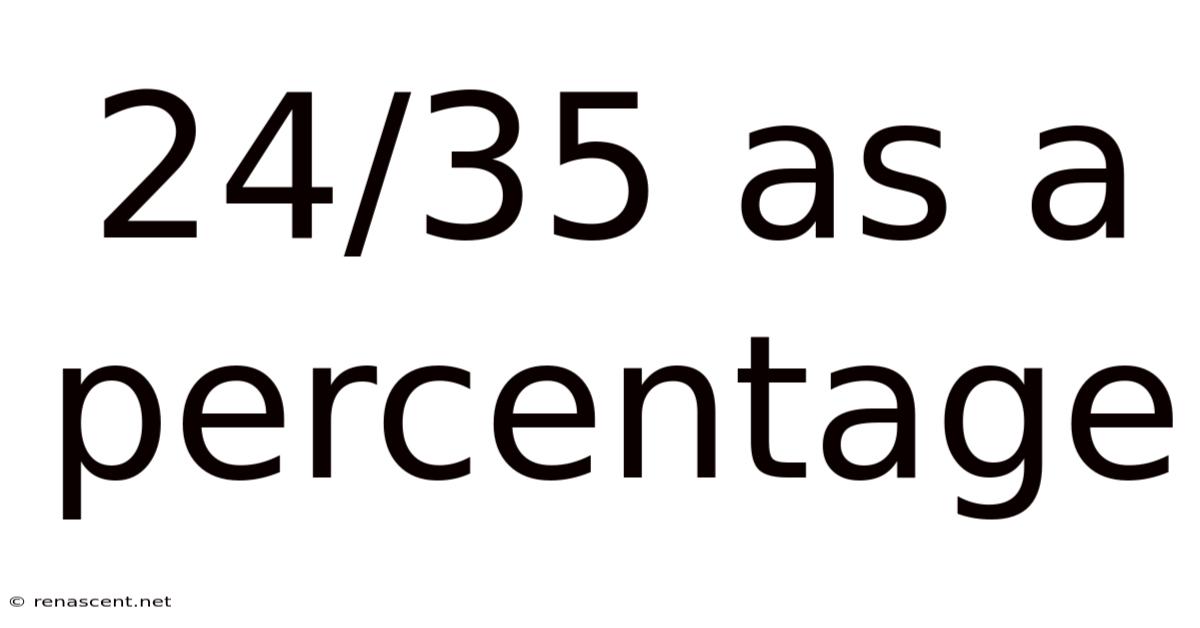24/35 As A Percentage
renascent
Sep 16, 2025 · 4 min read

Table of Contents
Understanding 24/35 as a Percentage: A Comprehensive Guide
Converting fractions to percentages is a fundamental skill in mathematics with applications across various fields, from finance and statistics to everyday life. This comprehensive guide will delve into the process of converting the fraction 24/35 into a percentage, exploring the underlying concepts, providing step-by-step instructions, and addressing common questions. We'll also examine the practical implications of understanding this conversion and explore related concepts to deepen your understanding.
Introduction: Fractions, Decimals, and Percentages
Before we tackle 24/35, let's refresh our understanding of the relationship between fractions, decimals, and percentages. They are all different ways of representing parts of a whole.
-
Fractions: Represent a part of a whole using a numerator (top number) and a denominator (bottom number). For example, 24/35 means 24 parts out of a total of 35 parts.
-
Decimals: Represent a part of a whole using a base-ten system. They are expressed using a decimal point, separating the whole number part from the fractional part.
-
Percentages: Represent a part of a whole as a fraction of 100. The symbol "%" indicates "per hundred." So, 50% means 50 out of 100, or 50/100.
Converting 24/35 to a Percentage: A Step-by-Step Approach
There are two primary methods to convert 24/35 to a percentage:
Method 1: Using Division
This method involves dividing the numerator by the denominator and then multiplying the result by 100.
-
Divide the numerator by the denominator: 24 ÷ 35 ≈ 0.6857
-
Multiply the result by 100: 0.6857 × 100 = 68.57
Therefore, 24/35 is approximately 68.57%.
Method 2: Finding an Equivalent Fraction with a Denominator of 100
While less practical for this specific fraction, this method illustrates the fundamental concept of percentages. The goal is to find an equivalent fraction where the denominator is 100. This is achieved by finding a number that, when multiplied by 35, results in 100 (or a multiple of 100). Unfortunately, there isn't a whole number that satisfies this condition for 35. However, we can use the division method (Method 1) for a more accurate and efficient solution.
Important Note: The result obtained using division (Method 1) is an approximation. The decimal representation of 24/35 is a non-terminating decimal, meaning it goes on infinitely. We round the result to a suitable number of decimal places depending on the required precision. In this case, we rounded to two decimal places (68.57%).
Understanding the Result: What Does 68.57% Mean?
The result, 68.57%, signifies that 24 represents approximately 68.57 parts out of every 100 parts of the whole represented by 35. This percentage can be used to compare proportions, represent data in a more easily understandable format, or perform further calculations.
Practical Applications of Percentage Conversions
The ability to convert fractions to percentages has widespread applications:
-
Finance: Calculating interest rates, discounts, profit margins, and tax rates.
-
Statistics: Representing data in charts and graphs, interpreting survey results, and understanding probabilities.
-
Everyday Life: Calculating tips in restaurants, understanding sale discounts, and comparing prices.
Further Exploration: Related Concepts
Understanding percentage conversions opens the door to exploring more advanced mathematical concepts:
-
Ratios and Proportions: Percentages are closely related to ratios and proportions, which are used to compare quantities.
-
Proportional Reasoning: This involves using ratios and proportions to solve problems involving proportional relationships.
-
Compound Interest: Understanding percentages is crucial for comprehending the growth of investments through compound interest.
Frequently Asked Questions (FAQ)
Q1: Why do we use percentages?
A1: Percentages provide a standardized way to compare proportions. Expressing values as percentages makes it easier to compare different quantities, regardless of their original units or scales.
Q2: What if I need a more precise percentage than 68.57%?
A2: You can increase the number of decimal places in your calculation. For example, 24/35 is approximately 68.5714%, providing greater accuracy. However, the choice of decimal places depends on the level of precision needed for the specific application.
Q3: Can I convert percentages back to fractions?
A3: Yes. To convert a percentage to a fraction, divide the percentage by 100 and simplify the resulting fraction. For example, 68.57% can be converted to the fraction 6857/10000. This can then be further simplified if needed.
Q4: Are there any online tools to help with percentage conversions?
A4: Yes, many online calculators and converters are available that can perform fraction-to-percentage conversions quickly and accurately. However, understanding the underlying process is important for developing a deeper mathematical understanding.
Conclusion: Mastering Percentage Conversions
Converting fractions like 24/35 into percentages is a vital skill in mathematics and across numerous disciplines. This guide has provided a comprehensive understanding of the conversion process, emphasizing the importance of both accuracy and conceptual understanding. By mastering this skill, you equip yourself with a powerful tool for problem-solving and data interpretation in various contexts. Remember, the ability to work comfortably with fractions, decimals, and percentages is a cornerstone of numerical literacy. Continue practicing and exploring related concepts to further enhance your mathematical abilities and confidence.
Latest Posts
Related Post
Thank you for visiting our website which covers about 24/35 As A Percentage . We hope the information provided has been useful to you. Feel free to contact us if you have any questions or need further assistance. See you next time and don't miss to bookmark.